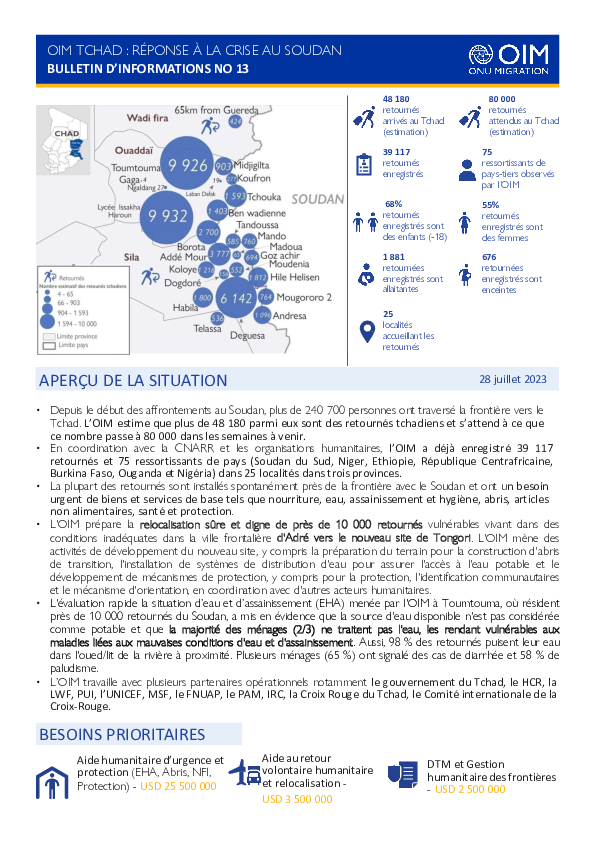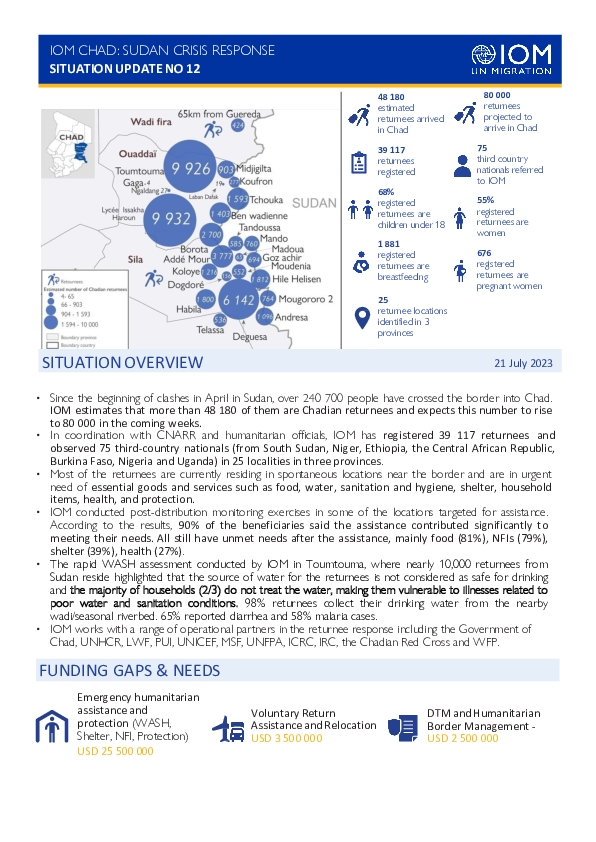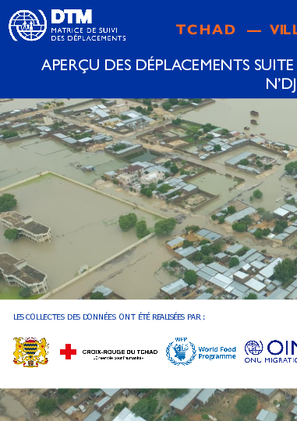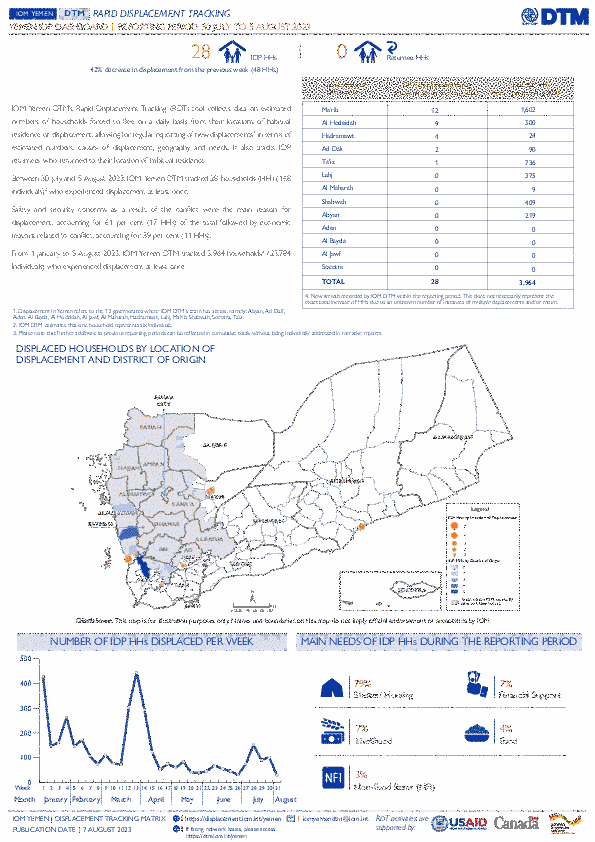-
Countries
-
Data and Analysis
-
Special Focus
-
Crisis Responses

Contact
DTM Chad, dtmtchad@iom.int
Language
English
Location
Chad
Period Covered
Jul 28 2023
Jul 28 2023
Activity
- Flow Monitoring Survey
- Flow Monitoring
Since the beginning of clashes in April in Sudan, over 240 700 people have crossed the border into Chad. IOM estimates that more than 48 180 of them are Chadian returnees and expects this number to rise to 80 000 in the coming weeks. In coordination with CNARR and humanitarian officials, IOM has registered 39 117 returnees and observed 75 third-country nationals (from South Sudan, Niger, Ethiopia, the Central African Republic, Burkina Faso, Nigeria and Uganda) in 25 localities in three provinces. Most of the returnees are currently residing in spontaneous locations near the border and are in urgent need of essential goods and services such as food, water, sanitation and hygiene, shelter, household items, health, and protection.
IOM is preparing the safe and dignified relocation of nearly 10,000 vulnerable returnees living in inadequate conditions in the border town of Adré to the new site of Tongori. IOM is conducting site development activities on the new site, including preparing the land for the construction of transitional shelters, installation of water distribution systems to ensure access to safe drinking water, and the development of protection mechanisms, including for community-based protection and identification and referral mechanism, in coordination with other humanitarian actors. The rapid WASH assessment conducted by IOM in Toumtouma, where nearly 10,000 returnees from Sudan reside highlighted that the source of water for the returnees is not considered as safe for drinking and the majority of households (2/3) do not treat the water, making them vulnerable to illnesses related to poor water and sanitation conditions. 98% returnees collect their drinking water from the nearby wadi/seasonal riverbed. 65% reported diarrhea and 58% malaria cases.
IOM works with a range of operational partners in the returnee response including the Government of Chad, UNHCR, LWF, PUI, UNICEF, MSF, UNFPA, ICRC, IRC, the Chadian Red Cross and WFP.

Contact
DTM Chad, dtmtchad@iom.int
Language
French
Location
Chad
Period Covered
Jul 28 2023
Jul 28 2023
Activity
- Flow Monitoring Survey
- Flow Monitoring
Depuis le début des affrontements au Soudan, plus de 240 700 personnes ont traversé la frontière vers le Tchad. L’OIM estime que plus de 48 180 parmi eux sont des retournés tchadiens et s’attend à ce que ce nombre passe à 80 000 dans les semaines à venir. En coordination avec la CNARR et les organisations humanitaires, l’OIM a déjà enregistré 39 117 retournés et 75 ressortissants de pays (Soudan du Sud, Niger, Ethiopie, République Centrafricaine, Burkina Faso, Ouganda et Nigéria) dans 25 localités dans trois provinces. La plupart des retournés sont installés spontanément près de la frontière avec le Soudan et ont un besoin urgent de biens et services de base tels que nourriture, eau, assainissement et hygiène, abris, articles non alimentaires, santé et protection.
L'OIM prépare la relocalisation sûre et digne de près de 10 000 retournés vulnérables vivant dans des conditions inadéquates dans la ville frontalière d'Adré vers le nouveau site de Tongori. L'OIM mène des activités de développement du nouveau site, y compris la préparation du terrain pour la construction d'abris de transition, l'installation de systèmes de distribution d'eau pour assurer l'accès à l'eau potable et le développement de mécanismes de protection, y compris pour la protection, l'identification communautaires et le mécanisme d'orientation, en coordination avec d'autres acteurs humanitaires. L'évaluation rapide la situation d’eau et d’assainissement (EHA) menée par l'OIM à Toumtouma, où résident près de 10 000 retournés du Soudan, a mis en évidence que la source d'eau disponible n'est pas considérée comme potable et que la majorité des ménages (2/3) ne traitent pas l'eau, les rendant vulnérables aux maladies liées aux mauvaises conditions d'eau et d'assainissement. Aussi, 98 % des retournés puisent leur eau dans l'oued/lit de la rivière à proximité. Plusieurs ménages (65 %) ont signalé des cas de diarrhée et 58 % de paludisme.
L’OIM travaille avec plusieurs partenaires opérationnels notamment le gouvernement du Tchad, le HCR, la LWF, PUI, l’UNICEF, MSF, le FNUAP, le PAM, IRC, la Croix Rouge du Tchad, le Comité internationale de la Croix-Rouge

Contact
DTM Chad, dtmtchad@iom.int
Language
English
Location
Chad
Period Covered
Jul 21 2023
Jul 21 2023
Activity
- Flow Monitoring Survey
- Flow Monitoring
Since the beginning of clashes in April in Sudan, over 240 700 people have crossed the border into Chad. IOM estimates that more than 48 180 of them are Chadian returnees and expects this number to rise to 80 000 in the coming weeks. In coordination with CNARR and humanitarian officials, IOM has registered 39 117 returnees and observed 75 third-country nationals (from South Sudan, Niger, Ethiopia, the Central African Republic, Burkina Faso, Nigeria and Uganda) in 25 localities in three provinces.
Most of the returnees are currently residing in spontaneous locations near the border and are in urgent need of essential goods and services such as food, water, sanitation and hygiene, shelter, household items, health, and protection. IOM conducted post-distribution monitoring exercises in some of the locations targeted for assistance. According to the results, 90% of the beneficiaries said the assistance contributed significantly to meeting their needs. All still have unmet needs after the assistance, mainly food (81%), NFIs (79%), shelter (39%), health (27%). The rapid WASH assessment conducted by IOM in Toumtouma, where nearly 10,000 returnees from Sudan reside highlighted that the source of water for the returnees is not considered as safe for drinking and the majority of households (2/3) do not treat the water, making them vulnerable to illnesses related to poor water and sanitation conditions. 98% returnees collect their drinking water from the nearby wadi/seasonal riverbed. 65% reported diarrhea and 58% malaria cases.
IOM works with a range of operational partners in the returnee response including the Government of Chad, UNHCR, LWF, PUI, UNICEF, MSF, UNFPA, ICRC, IRC, the Chadian Red Cross and WFP.

Contact
DTM Chad, dtmtchad@iom.int
Language
French
Location
Chad
Period Covered
Jul 21 2023
Jul 21 2023
Activity
- Flow Monitoring Survey
- Flow Monitoring
Depuis le début des affrontements au Soudan, plus de 240 700 personnes ont traversé la frontière vers le Tchad. L’OIM estime que plus de 48 180 parmi eux sont des retournés tchadiens et s’attend à ce que ce nombre passe à 80 000 dans les semaines à venir. En coordination avec la CNARR et les organisations humanitaires, l’OIM a déjà enregistré 39 117 retournés et 75 ressortissants de pays (Soudan du Sud, Niger, Ethiopie, République Centrafricaine, Burkina Faso, Ouganda et Nigéria) dans 25 localités dans trois provinces. La plupart des retournés sont installés spontanément près de la frontière avec le Soudan et ont un besoin urgent de biens et services de base tels que nourriture, eau, assainissement et hygiène, abris, articles non alimentaires, santé et protection.
L’OIM a mené des évaluations post-distribution dans certains des endroits ciblés pour l’assistance humanitaire. 90 % des bénéficiaires enquêtés ont déclaré que l’assistance reçue avait contribué de manière significative à répondre à leurs besoins. Tous ont encore des besoins non satisfaits, principalement 1) la nourriture (81%), les articles non alimentaires (79%), le logement (39%), la santé (27%). L'évaluation rapide la situation d’eau et d’assainissement (EHA) menée par l'OIM à Toumtouma, où résident près de 10 000 retournés du Soudan, a mis en évidence que la source d'eau disponible n'est pas considérée comme potable et que la majorité des ménages (2/3) ne traitent pas l'eau, les rendant vulnérables aux maladies liées aux mauvaises conditions d'eau et d'assainissement. Aussi, 98 % des retournés puisent leur eau dans l'oued/lit de la rivière à proximité. Plusieurs ménages (65 %) ont signalé des cas de diarrhée et 58 % de paludisme.
L’OIM travaille avec plusieurs partenaires opérationnels notamment le gouvernement du Tchad, le HCR, la LWF, PUI, l’UNICEF, MSF, le FNUAP, le PAM, IRC, la Croix Rouge du Tchad, le Comité internationale de la Croix-Rouge.

Contact
DTM Chad, dtmtchad@iom.int
Language
French
Location
Chad
Period Covered
Jun 23 2023
Jul 27 2023
Activity
- Mobility Tracking
- Event Tracking
Le suivi des urgences a pour but de recueillir des informations sur les mouvements importants et soudains de populations, ainsi que sur des urgences sécuritaires et climatiques. Les informations sont collectées par le biais d’entretiens avec des informateurs clés ou par des observations directes. Ce tableau de bord présente des informations sur les mouvements des personnes survenus dans la période du 23 juin au 27 juillet 2023 dans la province du Lac, au Tchad.
Durant, le mois de juillet 2023, outre les déplacements internes dus aux incidents sécuritaires dans le département de Fouli, les autorités locales et étatiques aux frontières ont rapporté un mouvement de 142 ménages (445 individus) de la sous-préfecture de Daboua vers le Niger. En effet, ces individus ont quitté notamment les sites de Keiga, Dabourom, Ngollom et Konguiyo. La raison principale de ce déplacement était la recherche d’assistance et de moyens de subsistance.
Alors qu’une accalmie a été observée dans la province du Lac durant le mois de juin 2023, le mois de juillet a connu une intensification des incidents sécuritaires qui ont causé un grand nombre de déplacements. Durant ces deux mois, 3 805 ménages (13 958 individus) ont été affectés par des déplacements. Il est à souligner que la vaste majorité des déplacements a été observée durant le mois de juillet 2023 avec 3 530 ménages (13 098 individus). La quasi-totalité (86%) des personnes affectées par les déplacements entre juin et juillet 2023 étaient membres des communautés locales avant leur déplacement. Ainsi, la raison de déplacement a principalement été les mouvements préventifs (89%). Durant les deux mois, la grande partie des personnes déplacées (soit 79%) se sont réfugiées dans des localités situées dans les mêmes sous-préfectures que leur lieu de provenance (voir le tableau sur les pages 2 et 3). Après leur déplacement, ces derniers ont généralement rapporté des besoins importants en articles non-alimentaires (33%), nourriture (25%), abris (21%), eau (13%) et santé (8%).

Contact
DTM Chad, dtmtchad@iom.int
Language
English
Location
Chad
Period Covered
Jun 23 2023
Jul 27 2023
Activity
- Mobility Tracking
- Event Tracking
The purpose of the Emergency Tracking Tool (ETT) is to collect information on large and sudden population movements as well as on security and climate emergencies. This dashboard provides information on movements which occurred during the period from 23 june to 27 july 2023, in Lac Province.
In July 2023, in addition to internal displacements due to security incidents in the Fouli department, local and state border authorities reported the movement of 142 households (445 individuals) from the Daboua sub-prefecture to Niger. These individuals left the Keiga, Dabourom, Ngollom and Konguiyo sites in particular. The main reason for this displacement was the search for assistance and means of subsistence.
While a lull was observed in the Lac province during the month of June 2023, an intensification of security incidents occurred in July, which caused a large number of displacements. During these two months, 3,805 households (13,958 individuals) have been affected by displacement. It should be noted that the vast majority of displacements were observed during July 2023 (3,530 households, 13,098 individuals were displaced). The quasi-totality (86%) of displaced individuals between June and July 2023 were locals before these new displacements. Indeed, the main reason for displacement was preventive movements (89%). During the two months, the majority of displaced individuals (79%) took refuge in localities situated in the same sous-prefectures as their provenance (see table on pages 2 and 3). After their displacement, they reported significant needs in non-food items (33%), food (25%), shelter (21%), water (13%) and health (8%).

Contact
DTM Chad, dtmtchad@iom.int
Language
French
Location
Chad
Period Covered
Mar 20 2023
Apr 09 2023
Activity
- Survey
- Mobility Tracking
- Baseline Assessment
- Village Assessment
Les données présentées dans ce rapport ont été collectées du 20 au 24 mars puis du 07 au 09 avril 2023 dans 9 sites accueillant encore des sinistrés dans la ville de N’Djamena, par les équipes de la Croix Rouge du Tchad avec l’appui de l’OIM et du Programme Alimentaire Mondial dans le cadre de la stratégie de retour du gouvernement. L’objectif était d’appuyer la fourniture d'une assistance ciblée aux personnes déplacées dans les sites, en collectant des informations sur leurs profils (vulnérabilités et besoins), leurs intentions de retour ainsi que des mesures envisagées pour la prochaine saison des pluies pour permettre un ciblage plus efficace, mais aussi d’avoir un format électronique de la liste des personnes déplacées dans ces sites.

Contact
DTM Yemen, iomyemendtm@iom.int
Language
English
Location
Yemen
Period Covered
Jul 30 2023
Aug 05 2023
Activity
- Mobility Tracking
IOM Yemen DTM’s Rapid Displacement Tracking (RDT) tool collects data on estimated numbers of households forced to flee on a daily basis from their locations of origin or displacement, allowing for regular reporting of new displacements in terms of estimated numbers, geography, and needs. It also tracks returnees who returned to their location of origin.
From 1 January to 5 August 2023, IOM Yemen DTM tracked 3,964 households (HH) (23,784 Individuals) who experienced displacement at least once.
Between 30 July and 5 August 2023, IOM Yemen DTM tracked 28 households (168 individuals) displaced at least once. The majority of people moved into/within the following governorates and districts:
- Ma’rib (12 HHs) – Ma’rib (7 HHs), Ma’rib City (5 HHs) districts. Most displacements in the governorate originated from Al Hodeidah and Sanaa City.
- Al Hodeidah (9 HHs) – Al Khukhah (6 HHs), Hays (3 HHs) districts. Most displacements in the governorate originated from Ta’iz and Al Hodeidah.
- Hadramawt (4 HHs) – Al Mukalla City (4 HHs) district. All displacements in the governorate originated from Al Hodeidah.
The majority of people moved from the following governorates and districts:
- Al Hodeidah (13 HHs) – Bayt Al Faqih (4 HHs), Hays (4 HHs), Bajil (2 HHs) districts.
- Ta’iz (7 HHs) – Maqbanah (5 HHs), Mawiyah (2 HHs) districts.
- Sanaa City (2 HHs) – Shuub (1 HH), Ath Thawrah (1 HH) districts.
Contact
DTM Yemen, iomyemendtm@iom.int
Location
Yemen
Activity
- Mobility Tracking
- Event Tracking
Period Covered
Jul 30 2023 -Aug 05 2023
From 1 January to 5 August 2023, IOM Yemen DTM tracked 3,964 households (HH) (23,784 Individuals) who experienced displacement at least once.
Between 30 July and 5 August 2023, IOM Yemen DTM tracked 28 households (168 individuals) displaced at least once. The majority of people moved into/within the following governorates and districts:
- Ma’rib (12 HHs) – Ma’rib (7 HHs), Ma’rib City (5 HHs) districts. Most displacements in the governorate originated from Al Hodeidah and Sanaa City.
- Al Hodeidah (9 HHs) – Al Khukhah (6 HHs), Hays (3 HHs) districts. Most displacements in the governorate originated from Ta’iz and Al Hodeidah.
- Hadramawt (4 HHs) – Al Mukalla City (4 HHs) district. All displacements in the governorate originated from Al Hodeidah.
- Al Hodeidah (13 HHs) – Bayt Al Faqih (4 HHs), Hays (4 HHs), Bajil (2 HHs) districts.
- Ta’iz (7 HHs) – Maqbanah (5 HHs), Mawiyah (2 HHs) districts.
- Sanaa City (2 HHs) – Shuub (1 HH), Ath Thawrah (1 HH) districts.
Population Groups
Survey Methodology
Unit of Analysis Or Observation
Type of Survey or Assessment
Keywords
Geographical Scope
Administrative boundaries with available data
The current dataset covers the following administrative boundaries

Contact
DTMUkraine@iom.int
Language
Ukrainian
Location
Ukraine
Period Covered
May 11 2023
Jun 14 2023
Activity
- Survey
Після 24 лютого 2022 року повномасштабне вторгнення Російської Федерації (РФ) в Україну спричинило безпрецедентну гуманітарну кризу по всій країні. У період з 11 травня по 14 червня 2023 року Міжнародна організація з міграції (МОМ) у два етапи провела раунд 13 репрезентативного оцінювання загального населення України для збору інформації стосовно переміщення, потоків мобільності, намірів та умов для інформаційного забезпечення цільової допомоги населенню, що постраждало від війни. Починаючи з раунду 13, методологію опитування було адаптовано для отримання репрезентативних квартальних даних на рівні областей. Крім того, в цьому раунді запроваджено новий блок питань щодо довгострокових рішень проблеми внутрішнього переміщення згідно з критеріями, пропонованими Рамковою програмою Міжвідомчого постійного комітету щодо довгострокових рішень для ВПО. Опитування загального населення має на меті сприяти ухваленню обґрунтованих рішень у стратегічному, технічному та програмному аспектах діяльності з реагування та відновлення в Україні, у тому числі Урядом України. Географічне охоплення цього оцінювання покриває всю територію України, за винятком Автономної Республіки Крим та районів Донецької, Луганської, Херсонської та Запорізької областей, які перебувають під тимчасовим військовим контролем РФ. Опитування загального населення було проведено шляхом набору випадкових телефонних номерів, завдяки чому було анонімно опитано 5 297 унікальних респондентів віком від 18 років із використанням методу автоматизованого телефонного опитування (CATI). Оцінки базуються на даних про населення ЮНФПА (останні доступні дані станом на 14 листопада 2022 р.), які гуманітарна спільнота розглядає як базове значення для чисельності населення в Україні. Особи, які наразі перебувають за межами України, під опитування не потрапили.